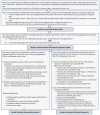Improving ventilator-associated event surveillance in the National Healthcare Safety Network and addressing knowledge gaps: update and review
- PMID: 24945615
- PMCID: PMC4638221
- DOI: 10.1097/QCO.0000000000000083
Improving ventilator-associated event surveillance in the National Healthcare Safety Network and addressing knowledge gaps: update and review
Abstract
Purpose of review: The Centers for Disease Control and Prevention (CDC) recently transitioned from ventilator-associated pneumonia (VAP) surveillance to ventilator-associated event (VAE) surveillance in adult inpatient settings. Since the transition, several modifications have been made to improve surveillance methods, and there is a growing body of data regarding the epidemiology, risk factors, and preventability of VAEs.
Recent findings: The VAE surveillance definition algorithm is based on objective criteria and includes three tiers: ventilator-associated conditions, infection-related ventilator-associated complications, and possible and probable VAP. VAE surveillance expands the purview of surveillance beyond pneumonia alone to include additional complications of mechanical ventilation. Most VAEs are caused by pneumonia, pulmonary edema, atelectasis, or acute respiratory distress syndrome. VAEs are associated with adverse outcomes including prolonged mechanical ventilation, longer intensive care and hospital length-of-stay, and higher mortality rates. Studies to date suggest that minimizing sedation and optimizing fluid management can reduce VAE rates.
Summary: We review the CDC's recent updates on VAE surveillance definitions, methods, and tools, and provide an overview of the growing evidence base for VAE as a patient safety measure. Further work is needed to affirm and extend the current knowledge about how best to prevent VAEs.
Conflict of interest statement
Dr. Klompas receives funding from the Centers for Disease Control and Prevention and has received honoraria from Premier, Inc. for lectures on VAE surveillance. Drs. Rhodes and Magill have no conflicts to disclose.
Figures
References
-
- Safdar N, Dezfulian C, Collard HR, Saint S. Clinical and economic consequences of ventilator-associated pneumonia: a systematic review. Crit Care Med. 2005 Oct;33(10):2184–93. - PubMed
-
- Magill SS, Klompas M, Balk R, et al. Developing a new, national approach to surveillance for ventilator-associated events. Crit Care Med. 2013;41(11):2467–75. This is the full report of the VAE Surveillance Definition Working Group; it provides a comprehensive description of the rationale and process for developing and implementing VAE surveillance in the CDC’s NHSN. - PMC - PubMed
-
- Klompas M. Complications of mechanical ventilation--the CDC’s new surveillance paradigm. N Engl J Med. 2013 Apr 18;368(16):1472–5. - PubMed
-
- Hayashi Y, Morisawa K, Klompas M, et al. Toward improved surveillance: the impact of ventilator-associated complications on length of stay and antibiotic use in patients in intensive care units. Clin Infect Dis. 2013 Feb;56(4):471–7. - PubMed
Publication types
MeSH terms
Grants and funding
LinkOut - more resources
Full Text Sources
Other Literature Sources
Research Materials


